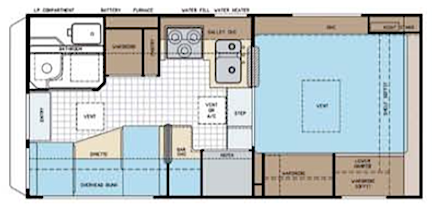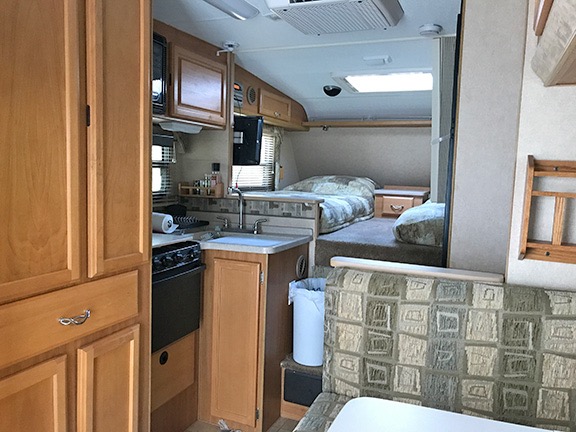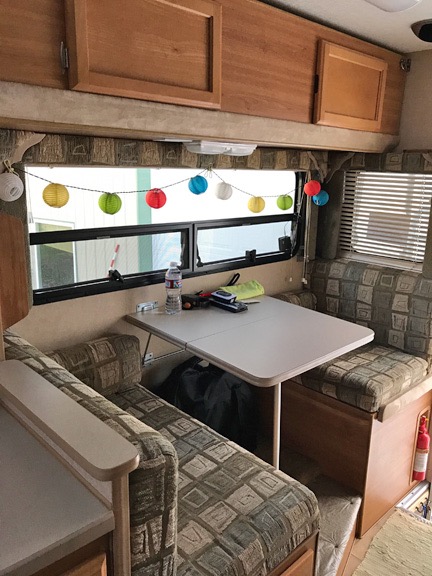I take delivery of a newer, smaller truck camper.
Regular readers might remember that I spent this past winter in Arizona and California, doing my best to avoid the dark and dreary winters of north central Washington state where I normally live. I had sold my big fifth wheel camper, the Mobile Mansion late in the summer of 2016 after purchasing my first truck camper, the Turtleback. I took the Turtleback south just before Thanksgiving and spent the winter living in a friend’s guest house, camping on mostly BLM land with friends, and traveling around Washington, Oregon, Nevada, Arizona, and California.
The Turtleback was pretty deluxe. It had basically every single feature you can cram into a truck camper, including a slide to give me lots of space. It was huge for what it was and although it was comfortable, it was also heavy. I decided, on my trip south, that I’d keep an eye out for a replacement and, if I found one, I’d trade it in. I wanted something slightly smaller — certainly without the slide, which I didn’t need — and perhaps a little newer. (The Turtleback, although in near new condition, was a 2005 model.)
Finding a Replacement for the Turtleback

The standard 2007 Lance 950 floorpan.
I found the Turtleback’s replacement on the last day of my trip. I stopped by the Lance dealer in Yakima to see what they had among the used truck campers. They only had one — and it was one of the ones I’d seen there on my way south.

The kitchen is compact but the sink is bigger and the propane stove includes an oven so I can bake without running a generator.

The “food prep” area is beside the 6 cubic foot refrigerator with separate freezer.
It was the same physical size as the Turtleback, but 400 pounds lighter, mostly because it didn’t have a slide. It had an oven and a microwave — the Turtleback had a convection microwave so I needed power to bake — and a lot more interior storage space, including cabinets over the dining area and a much larger pantry. And although the kitchen area was just as tiny as the Turtleback’s it did have a “food prep” area beside the refrigerator.
It had two 5-gallon propane tanks instead of two 7-gallon ones; that was actually good for me because the 7-gallon tanks are wicked heavy when full and tough for me to lift into place. It even had the sunroof over the sleeping area, which I’d grown to love.

The view from the dining area.
The only weird thing: it had two narrow twin beds instead of a standard queen bed. The mattresses could be zipped together to make a queen bed if I wanted one. But the setup actually added more functionality — I could travel with someone I didn’t want to sleep with without turning the dining area into a bed.

It has two twin beds with a moveable night table between them. The mattresses zip together to make a queen bed if I find the perfect travel companion. Until then, I’ll likely leave them like this.
 Because the dining area isn’t on a slide, there’s storage overhead. That cabinet actually folds down to be used as a bunk for kids or a huge storage shelf. (And yes, I already hung my solar Chinese lanterns.)
Because the dining area isn’t on a slide, there’s storage overhead. That cabinet actually folds down to be used as a bunk for kids or a huge storage shelf. (And yes, I already hung my solar Chinese lanterns.)
It didn’t have a generator or solar panel, but I have a 2KW Honda generator I bought years ago and the portable solar panel I’d bought in Quartzsite in January. And instead of a satellite dish, which was useless to me because I don’t subscribe to satellite or cable TV, it had a regular RV TV antenna.
The bathroom was about the same microscopic size. Maybe an inch bigger.
And although it was a 2007 model, it was in very good condition.
In all, it was pretty much exactly what I was looking for. Smaller, lighter, and better designed.
For some reason — probably the beds — it wasn’t selling. Since their lot was crammed with new units, they were eager to get rid of it. They offered me a deal I couldn’t refuse. The only drawback was that the trade-in deal they offered absolutely sucked. I knew I could get a lot more for the Turtleback if I sold it on my own. They kindly offered to hold it for two months with a $500 deposit. I gave them a check and went home.
Selling the Turtleback
It took a week or two to clean out the Turtleback and get it ready for sale. Since my garage was still full of boats, I parked it near my shed. I put an ad on Craig’s List. The calls started coming almost immediately. The only problem was, folks were calling from Montana, Idaho, and the Olympic Peninsula — 5 or more hours away. I honestly don’t know why they bothered if they didn’t intend to come take a look. I certainly wasn’t about to deliver.
One guy told me he’d take it sight unseen. He’d come on Monday. By Sunday, however, he’d changed his mind. His wife had talked him into looking for a pull trailer.
A few days went by I still had more than a month to sell it, but when the calls suddenly stopped coming, I started getting worried. But then another call came. I answered questions. He was definitely interested but would be coming from the west side near Seattle. A few more phone calls and he and his wife arrived.
I showed them everything. They asked lots of questions. They tried everything — including the air conditioner, which wasn’t easy to get going when the outside temperatures were around 50°F. They talked it over in private. They offered $2K less than I was asking. I told them I really needed more and countered for $1K higher. They handed me a stack of $100 bills that had already been counted. I recounted them and it was right.
A while later, they drove away with the Turtleback on the back of their pickup. They’d gotten a good deal. I’d gotten $1,000 more for the Turtleback than I needed for its replacement — and $5,000 more than the trade-in offer had been for.
Picking Up Turtleback 2
Although I still had a whole month to get the new camper, I was eager to take possession. Cherry season would start soon and I was hoping to take it on a shakedown trip before I was stuck here. (I can’t travel during cherry season because I’m on standby for work.)
I scheduled a date to pick it up and drove down to Yakima to get it. I wound up spending about three hours, mostly chatting with the two brothers that own the place while their guys put the camper on my truck, inflated the air bags on my truck’s back end to level it, and strapped it down. Then I got the unit tour, which included an overview of everything on the camper. When I voiced disappointment that the TV/DVD player was AC rather than DC, the younger brother, Mike, gave me a 375 watt inverter. (Since the TV only draws 38 watts, I’ve since replaced it with a fanless 100 watt inverter.) So yes, I can still watch movies when I’m off-the-grid.
It felt the same as the Turtleback on the way home, although the brochure says the center of gravity is three inches higher.
Of course, I needed a name for it. Since it was my second Turtleback camper, I called it Turtleback 2 or just T2.
Plans for T2
It was parked in my driveway for about a week. Some overnight guests camped out in there. It was nice to have a place to put them.
I finally put it away in the garage yesterday. I’d planned on going on a trip down to Palouse Falls, but other things popped up on my calendar and it made sense to put it away rather than leave it out in the sun.
I’ll be using it in about 10 days on a Puget Sound Mycological Society weekend-long field trip to Silver Falls. Then maybe again on Memorial Day weekend. And likely the first weekend in June for another mushroom hunting field trip before cherry season starts.
Last summer, the Turtleback was a home for three different pilots who worked for me in Quincy. Although I don’t think I’ll need it for that duty this summer, it will be available.
And there’s a slight chance I’ll get a contract job in the Yakima area in September; if I do, I’ll stay down there in the T2.
Of course, I’ll be taking it south with me again next winter. And this time, I’ll bring along my boat.
Discover more from An Eclectic Mind
Subscribe to get the latest posts sent to your email.

If your RV preference is to relocate regularly (instead of staying long-term at a park), slide-in truck campers are SO much more convenient that towing a trailer. When you’re pulling a trailer, especially a long, expensive camp trailer, the logistics of turning around and backing up are always in the back of your mind. If not, they will be shortly after the first time you find yourself stuck at a dead-end doing a 27-point K-turn, trying to get your rig turned around without breaking or bending anything. Extra points for in the dark, or solo, or with a whole line of irritated motorists stuck behind you watching the whole fiasco, or all of the above!
Not worrying about whether you’ll be able to get in and out of a spot opens up a lot of possibilities that you would probably just avoid when towing. Truck campers are ready to go when you are, all you have to do is just drive away. You don’t have to deal with the elaborate procedure of cranking up the stabilizer jacks, hooking up and adjusting a load equalizing hitch or backing under a 5th wheel. When you find a good spot for the night, you just put it in park, set the brake, and you’re done. On the negative side, with a slide-in your truck is carrying ALL the weight, and you really feel the load when going around corners. No extra sets of tires or brakes means your stopping distance can be pretty long. And you REALLY need to make sure that you have top-notch, load-rated tires in good condition. Having heard a few horror stories, a blow-out with a heavy camper in the back is something that I hope never to experience myself. This is also one situation where dual rear wheels on your pickup are a real asset, instead of the PITA that they usually are.
I hope it works out for you, and I’ll bet Penny loves the extra bed up top. :)
You are preaching to the choir. I had a 35′ Fifth wheel for years. It was wonderful to LIVE in but not so fun to TRAVEL with. This truck camper is great. I can take my “home” anywhere I can take my truck — which is pretty much anywhere.
I definitely agree about the load, though. Dry weight is 3040 pounds. Add equipment, water, food, and luggage and it’s got to be close to 4000 pounds. Still a lot lighter than the 15,000 pounds I used to tow, but ALL of this weight is on the truck. I bought good tires in February 2016 and I suspect I’ll be buying another set sometime this coming winter. Ouch.
Good tires aren’t cheap, but in this case they’re cheap insurance. The higher they’re rated for air pressure the better, as all tires run cooler at higher PSI. It’s definitely possible to roll your truck if you blow a tire on a sharp curve, which unfortunately is also when the load on the outside tire is highest. Again, this is where the dual rear tire rigs shine, though they’re a PITA the rest of the time, especially when parking. Camper manufacturers try to put the heaviest stuff (especially tankage) down low when they design them, which helps a lot. Working against that is the human tendency to prefer our storage up high where we can see it without bending over. The more storage, the more weight up high, and things like canned goods, tools, etc., add up fast.
Yeah, I’m trying to pack light stuff high and heavy stuff low. I don’t like the way it feels going around curves. That’s one of the reasons I sold the old one. I said “too heavy” but I meant “too top heavy.”
The complexity of your work/ leisure balance means that the T2 makes perfect sense as you move around so often.
We used to tow a caravan (think mini mansion) for holidays and it was great for a while but the hassle of reversing it up narrow country lanes when pig-headed bus drivers refused to back-up five yards, began to tip the balance in favour of an RV. But then we found we used it less and less as RVs have their own problems. Parking in towns and cities is a nightmare as bays are not as generous in the UK as in the US.
We now just rent at our chosen destination. What is lost in freedom is compensated by fewer worries on the journey and a great saving by not having to buy and maintain expensive complex kit.
I use mine enough to make it worth owning one, especially since I do so much dry camping, which is often free. I figure I saved thousands of dollars on lodging this winter.